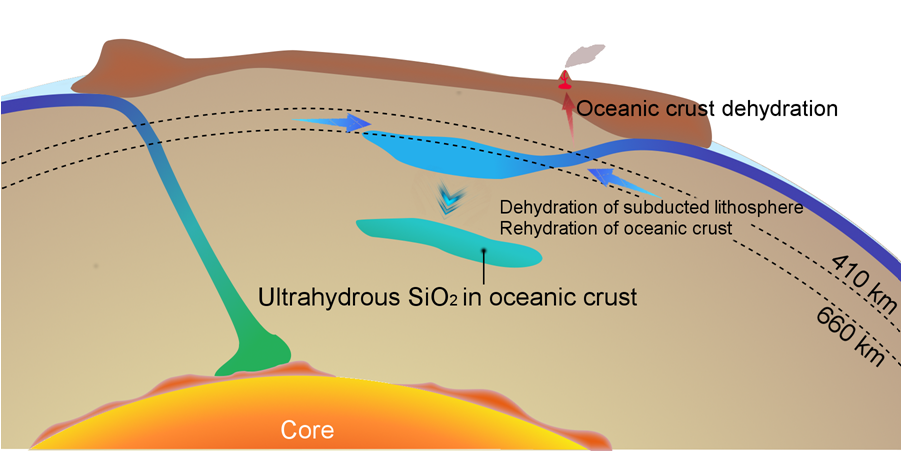Ultrahydrous stishovite in Earth's lower mantle - Drs. Qingyang Hu and Ho-kwang Mao
DECEMBER 17, 2019
New study from a team of scientists co-led by Drs. Qingyang Hu and Ho-kwang Mao from HPSTAR, discovered that stishovite — a major mineral in deep mantle, can incorporate large amounts of water in its crystal structure and the hydrous stishovite may be a key phase for transporting and storing water in earth lower mantle. The research is published in the recent issue of the journal Proceedings of the National Academy of Sciences.
We know that there is a great abundance of water on Earth’s surface which makes it a blue planet. On the surface, water cycles are generally running through the movement of glacier, cloud and rainfalls. How water is transported into the Earth’s deep interior and which minerals act as the carriers?
“To get down into the mantle, water must be incorporated into minerals on the surface and then remain stable in minerals under the conditions found deep inside the planet,” explained lead author Dr. Lin.
Previous work already revealed that silicate minerals have stored substantial amounts of water in the Earth’s upper mantle and transition zone conditions. The team of scientists utilized laser-heated diamond anvil cell to mimic the lower mantle condtions, they found that stishovite, a key mineral of deep mantle, is capable of storing and transporting large amounts of water even under extreme conditions like those found in Earth’s lower mantle.
They are the first who provided in situ experimental evidence for stishovite storing weight percent levels of water along the deep Earth conditions. “Dry stishovite will get rehydrated when it meets hydrous melt or fluid,” explained Dr. Lin. “In some localized regions of Earth’s interior, like the mid-ocean ridge basalt (MORB), stishovite becomes a modally abundant phase with roughly 23 % by number at the lower mantle conditions”.
“Stishovite is a silica-based mineral and a major component of the oceanic crust.” explained Mao. “In plate tectonics, there are areas called subduction zones where an oceanic plate slides beneath a continental plate, sinking from the Earth’s surface into its depths. When this happens, stishovite is transported into the mantle.”
The results indicate hydrous stishovite is among the many candidates of so-called dense hydrous phases that were only realized in the last decade. Compared with other dense hydrous minerals, stishovite silica can still hold a great deal of water at very high temperatures.

Caption: Transportation of water into the lower mantle by ultrahydrous SiO2.
This story was adapted from a press release by CARNEGIE INSTITUTION FOR SCIENCE.
媒体报道:
CarnegieScience: https://obs.carnegiescience.edu/news/would-deep-earth-water-cycle-change-how-we-understand-planetary-evolution
EurekAlert: https://sciencesources.eurekalert.org/pub_releases/2019-12/cifs-wad121619.php
地球表面的水循环主要通过蒸发,凝结等过程进行。对于地球内部,水需要进入矿物的结构中形成稳定的含水矿物来实现水的存储,输运。北京高压科学研究中心胡清扬研究员与与卡内基研究中心的林彦蒿合作的最新研究发现二氧化硅的高压相 — 斯石英(Stishovite)在地球下地幔条件下可以容纳大量的水并能形成的稳定结构。该研究表明斯石英可能是地幔深部水循环的主要载体。斯石英作为洋壳深俯冲下的主要矿物组成之一,这一发现也为解决长期以来关于地球深部水传输的问题提供了新的思路。这也为我们进一步理解地球深部的氢-氧循环提供了新的窗口。相关研究以“Evidence for the stability of ultrahydrous stishovite in Earth’s lower mantle”为题发表于最近的《美国科学院院报》。
